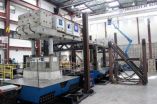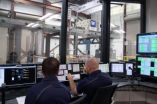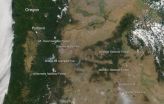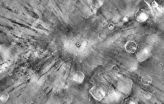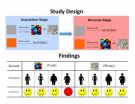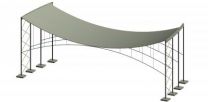(Press-News.org) VIDEO:
A 70-foot-long, 52-ton concrete bridge survived a series of earthquakes in the first multiple-shake-table experiment in the University of Nevada, Reno's new Earthquake Engineering Lab, the newest addition to the...
Click here for more information.
RENO, Nev. – A 70-foot-long, 52-ton concrete bridge survived a series of earthquakes in the first multiple-shake-table experiment in the University of Nevada, Reno's new Earthquake Engineering Lab, the newest addition to the world-renowned earthquake/seismic engineering facility.
"It was a complete success. The bridge withstood the design standard very well and today went over and above 2.2 times the design standard," John Stanton, civil and environmental engineering professor and researcher from the University of Washington, said. Stanton collaborated with Foundation Professor David Sanders of the University of Nevada, Reno in the novel experiment.
"The bridge performed very well," Sanders said. "There was a lot of movement, about 12 percent deflection – which is tremendous – and it's still standing. You could hear the rebar inside the columns shearing, like a zipper opening. Just as it would be expected to do."
The set of three columns swayed precariously, the bridge deck twisted and the sound filled the cavernous laboratory as the three 14- by 14-foot, 50-ton-capacity hydraulically driven shake tables moved the massive structure.
"Sure we broke it, but we exposed it to extreme, off-the-scale conditions," Stanton said. "The important thing is it's still standing, with the columns coming to rest right where they started, meaning it could save lives and property. I'm quite happy."
The bridge was designed and the components were pre-cast at the University of Washington in Seattle, and then built atop three 14- by 14-foot, 50-ton-capacity hydraulically driven shake tables in the 24,500 square-foot lab. It was shaken in a series of simulated earthquakes, culminating in the large ground motions similar to those recorded in the deadly and damaging 1995 magnitude 6.9 earthquake in Kobe, Japan.
The rocking, pre-tensioned concrete bridge support system is a new bridge engineering design the team has developed with the aim of saving lives, reducing on-site construction time and minimizing earthquake damage.
"By building the components off-site we can save time with construction on-site, minimizing interruptions in traffic and lowering construction costs," Sanders said. "In this case, the concrete columns and beams were pre-cast and tensioned at the University of Washington. Other components were built here at the University of Nevada, Reno. It took us only a month to build the bridge, in what would otherwise be a lengthy process."
"This can't be done anywhere else in the nation, and perhaps the world," Ian Buckle, director of the lab and professor of civil engineering, said of the test. "Of course we've been doing these types of large-scale structures experiments for years, but it's exciting to have this first test using multiple tables in this building complete. It's good to see the equipment up and running successfully.
When combined with the University's Large-Scale Structures Laboratory, just steps away from the new lab, the facility comprises the biggest, most versatile large-scale structures, earthquake/seismic engineering facility in the United States, according to National Institute of Standards and Technology, and possibly the largest University-based facility of its kind in the world.
A grand opening was held recently for the $19 million lab expansion project, funded with $12.2 million by the U.S. Department of Commerce's National Institute of Standards and Technology, funds from the Department of Energy, as well as University and donor funds. The expansion allows a broader range of experiments and there is additional space to add a fifth large shake table.
"Our facility is unique worldwide and, combined with the excellence of our faculty and students, will allow us to make even greater contributions to the seismic safety of our state, the nation and the world," Manos Maragakis, dean of the College of Engineering, said. "We will test new designs and materials that will improve our homes, hospitals, offices and highway systems. Remarkable research is carried on here. Getting to this point has taken a lot of hard work. It's both a culmination and a beginning, ushering in a new era."
INFORMATION:
The University of Nevada, Reno earthquake simulation facility is managed as a national shared-use NEES equipment site created and funded by the National Science Foundation to provide new earthquake engineering research testing capabilities for large structural systems.
The rocking bridge-bent accelerated bridge construction project is sponsored by the National Science Foundation George Brown Network for Earthquake Engineering Systems Research Program (Award #1207903).
For more technical information about the experiment, see the news release posted at the NEES website: https://nees.org/announcements/new-bridge-design-improves-earthquake-resistance-reduces-damage-and-speeds-construction.
YouTube of bridge shaking: https://www.youtube.com/watch?v=6jkdsIfs6pU
Time-lapse and photo gallery of construction of the new laboratory: http://imedia.unr.edu/ShakerTables/.
Time-lapse video of bridge construction: http://youtu.be/MjDcEA4f40M.
Founded in 1874 as Nevada's land-grant university, the University of Nevada, Reno ranks in the top tier of best national universities. With nearly 19,000 students, the University is driven to contribute a culture of student success, world-improving research and outreach that enhances communities and business. Part of the Nevada System of Higher Education, the University has the system's largest research program and is home to the state's medical school. With outreach and education programs in all Nevada counties and home to one of the largest study-abroad consortiums, the University extends across the state and around the world. For more information, visit http://www.unr.edu.
70-foot-long, 52-ton concrete bridge survives series of simulated earthquakes
University of Nevada, Reno's new Earthquake Engineering Lab hosts multiple-shake-table experiments
2014-07-16
ELSE PRESS RELEASES FROM THIS DATE:
Dozens of fires plague Oregon
2014-07-16
Fires are a way of life during the hot, dry summer days, but that does not mean they are ever taken for granted. Thousands of lightning strikes Sunday (7/13) and early Monday (7/14) probably started most of the wildfires, which are burning on private, public and reservation land. Dozens of fires are plaguing the forest areas in the state of Oregon. In this image, are shown the Buzzard Fire, the Shaniko Butte fire, the Bridge 99 Complex fire, and the Saddle Draw Fire.
The Buzzard Complex fire began as a lightning strike. Difficult terrain, combined with extremely dry ...
Arizona State University, US Geological Survey project yields sharpest map of Mars surface properties
2014-07-16
Tempe, Ariz. -- A heat-sensing camera designed at Arizona State University has provided data to create the most detailed global map yet made of Martian surface properties.
The map uses data from the Thermal Emission Imaging System (THEMIS), a nine-band visual and infrared camera on NASA's Mars Odyssey orbiter. A version of the map optimized for scientific researchers is available at the U.S. Geological Survey (USGS).
The new Mars map was developed by the Geological Survey's Robin Fergason at the USGS Astrogeology Science Center in Flagstaff, Ariz., in collaboration ...
Organismal biologists needed to interpret new trees of life
2014-07-16
Rapidly accumulating data on the molecular sequences of animal genes are overturning some standard zoological narratives about how major animal groups evolved. The turmoil means that biologists should adopt guidelines to ensure that their evolutionary scenarios remain consistent with new information—which a surprising number of scenarios are not, according to a critical overview article to be published in the August issue of BioScience and now available with Advance Access.
The article, by Ronald A Jenner of the Natural History Museum in London, describes how evolutionary ...
When it comes to food, obese women's learning is impaired
2014-07-16
Obese women were better able to identify cues that predict monetary rewards than those that predict food rewards, according to a study by Yale School of Medicine researchers and their colleagues in the journal Current Biology. The findings could result in specific behavioral interventions to treat obesity.
"Instead of focusing on reactions to the food itself, such interventions could focus on modifying the way in which obese individuals learn about the environment and about cues predicting food rewards," said lead author Ifat Levy, assistant professor of comparative medicine ...
Oregon study details brain pathways linking visual function, running
2014-07-16
EUGENE, Ore. – (July 16, 2014) – A new study by researchers at the University of Oregon published today in the journal Neuron describes a brainstem circuit in mice that may help explain how active movement impacts the way the brain processes sensory information.
"Previous studies have examined changes in the visual cortex of mice during running. What was unknown was how do running and vision get linked together in the first place?" said Cristopher Niell, a biology professor in the Institute of Neuroscience and the senior author on the paper "Identification of a Brainstem ...
Efficient structures help build a sustainable future
2014-07-16
CORAL GABLES, Fla. (July 14, 2014) -- When envisioning a new structure, engineers often have to balance design choices against the environmental impact of materials used. It is estimated that 40 to 50 percent of greenhouse gases are produced by the construction industry, according to the California Integrated Waste Management Board. Lessening the impact of construction on the environment is a work in progress.
Researchers at the University of Miami (UM) and the University of Milwaukee School of Engineering are searching for designs and materials that are less harmful ...
A natural way to monitor, and possibly control populations of, stink bugs
2014-07-16
Anyone who has squashed a stink bug knows why they got their name. Although just a nuisance to homeowners, the insects feed on and damage fruits and vegetables, causing significant economic losses for farmers. Now scientists report in ACS' Journal of Natural Products that they've discovered certain stink bug pheromone components and made them artificially in the lab for the first time, and these substances can be used to monitor and manage their populations.
Ashot Khrimian and colleagues explain that the brown marmorated stink bug, also known as Halyomorpha halys, is ...
Abdominal aortic aneurysms: Mayo Clinic surgeon explains who needs screening, treatment
2014-07-16
Rochester, Minn. — An abdominal aortic aneurysm is a potentially life-threatening condition: If the body's major blood vessel ruptures, it can prove deadly. The U.S. Preventive Services Task Force recently updated its recommendations on screening. Mayo Clinic vascular surgeon Peter Gloviczki, M.D., explains who should be watched for abdominal aortic aneurysms, how they are diagnosed and how surgery, which now includes a less invasive endovascular option, is improving survival rates:
MULTIMEDIA ALERT: Video and audio are available for download on the Mayo Clinic News Network.
What ...
ORNL, UTGSM study compares structures of Huntington's disease protein
2014-07-16
OAK RIDGE, Tenn., July 16, 2014 -- Neutron scattering research at the Department of Energy's Oak Ridge National Laboratory has revealed clear structural differences in the normal and pathological forms of a protein involved in Huntington's disease.
Huntington's disease, an incurable neurodegenerative disorder, starts as a genetic mutation that leads to an overabundance of "huntingtin" protein fragments, which form clumps in the brain.
Valerie Berthelier of the University of Tennessee Graduate School of Medicine, who co-led the study published in Biophysical Journal ...
Expert guidance on hand hygiene in healthcare settings
2014-07-16
CHICAGO (July 16, 2014) – Expert guidance released today offers updated evidence reviews and recommendations for hand hygiene in healthcare facilities. The guidance is featured in the August issue of Infection Control and Hospital Epidemiology and emphasizes best practices for implementing and optimizing hand hygiene programs to prevent the spread of healthcare-associated infections (HAIs). The guidance is part of the Compendium of Strategies to Prevent Healthcare-Associated Infections in Acute Care Hospitals: 2014 Updates produced in a collaborative effort led by the Society ...
LAST 30 PRESS RELEASES:
Tracing the quick synthesis of an industrially important catalyst
New software sheds light on cancer’s hidden genetic networks
UT Health San Antonio awarded $3 million in CPRIT grants to bolster cancer research and prevention efforts in South Texas
Third symposium spotlights global challenge of new contaminants in China’s fight against pollution
From straw to soil harmony: International team reveals how biochar supercharges carbon-smart farming
Myeloma: How AI is redrawing the map of cancer care
Manhattan E. Charurat, Ph.D., MHS invested as the Homer and Martha Gudelsky Distinguished Professor in Medicine at the University of Maryland School of Medicine
Insilico Medicine’s Pharma.AI Q4 Winter Launch Recap: Revolutionizing drug discovery with cutting-edge AI innovations, accelerating the path to pharmaceutical superintelligence
Nanoplastics have diet-dependent impacts on digestive system health
Brain neuron death occurs throughout life and increases with age, a natural human protein drug may halt neuron death in Alzheimer’s disease
SPIE and CLP announce the recipients of the 2025 Advanced Photonics Young Innovator Award
Lessons from the Caldor Fire’s Christmas Valley ‘Miracle’
Ant societies rose by trading individual protection for collective power
Research reveals how ancient viral DNA shapes early embryonic development
A molecular gatekeeper that controls protein synthesis
New ‘cloaking device’ concept to shield sensitive tech from magnetic fields
Researchers show impact of mountain building and climate change on alpine biodiversity
Study models the transition from Neanderthals to modern humans in Europe
University of Phoenix College of Doctoral Studies releases white paper on AI-driven skilling to reduce burnout and restore worker autonomy
AIs fail at the game of visual “telephone”
The levers for a sustainable food system
Potential changes in US homelessness by ending federal support for housing first programs
Vulnerability of large language models to prompt injection when providing medical advice
Researchers develop new system for high-energy-density, long-life, multi-electron transfer bromine-based flow batteries
Ending federal support for housing first programs could increase U.S. homelessness by 5% in one year, new JAMA study finds
New research uncovers molecular ‘safety switch’ shielding cancers from immune attack
Bacteria resisting viral infection can still sink carbon to ocean floor
Younger biological age may increase depression risk in older women during COVID-19
Bharat Innovates 2026 National Basecamp Showcases India’s Most Promising Deep-Tech Ventures
Here’s what determines whether your income level rises or falls
[Press-News.org] 70-foot-long, 52-ton concrete bridge survives series of simulated earthquakesUniversity of Nevada, Reno's new Earthquake Engineering Lab hosts multiple-shake-table experiments

